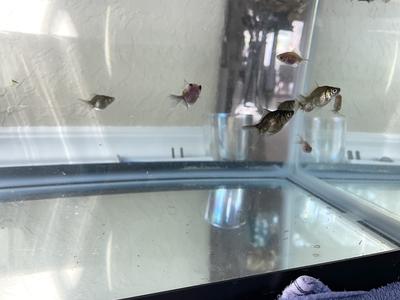- Home
- FAQs (frequently asked questions)
- Black Moor/Calico Telescope Eyed Goldfish
Black Moor/Calico Telescope Eyed Goldfish
by Anna
(Florida)

Around a month ago my goldfish bred, and I found your website (which has been so helpful, thank you!!) but need advice on temperature for color change because I am a little confused. So, I know for sure the female is a black moor, however I have two males with her - another black moor and a calico telescope eyed goldfish.
I only collected about 16 eggs which I put in a 29 g tank but only filled the water to height that is suggested in your article… Fast forward about a month now since they became free swimming and I now have 16 fish fry which are roughly all around an inch long with slight variants of a cm or two.
At the beginning I was very strict about feed baby brine shrimp that I hatched as suggested in your post now, they get a mix of that or store bought frozen baby brine shrimp or frozen daphnia when I don't have live. I have attached picture below because I clearly have a mix of calico and (hopefully) black moor. I don't know the breeding lineage history so I don't know if they have been bred well or not & I am not breeding for perfection or to be a breeder, just because I love my fish babies.
I saw on your post that metallic scaled goldfish water temp should be higher for optimal color change so I did raise the temp to around 78F for around a week and did notice that the gray/brown ones became darker- almost black- and the "calico" ones did develop more color. However, I went back to your post to check something and read that black moor are an exception to temp raise since there has been some studies suggesting it will make for red/orange moor so I then lowered the temp a couple days ago to 75F because I wasn't sure and I feel like some have since gotten lighter. So my question is what temp should I have the tank at preferably for both colors? What will happen to the calico if the temp for black moor is favored? Have I completely screwed up? HAHA Will the brownish ones become black?
I know the two color types should be separate but I don't have another tank to do that and have so many going already, I don't think I can handle another one but I am watching a friends fish who is going to pick them up somewhat soon so in the near future I will have a 10 g tank that I can put the calico in probably because I feel like there are less of those. Also, when can I fill the tank completely up and switch from a sponge filter to a normal filter?
When can I put one back with its parents (who I have also attached pictures of for reference)? Do you know when or if their eyes will develop to be telescoped?
Sorry, I know that is a lot of questions and text…. Also, I am sorry the pictures aren't the best, they are the best I could do.
Grant's Reply
Hi Anna
Firstly, congratulations on raising this many fry from eggs into healthy juveniles. Few manage to do so. Attaining this size in a month confirms you are doing everything right.
Let’s address the questions in order.
Feeding
Juveniles of this size can now be transitioned on to your preferred food. I feed gel food because my Black Moor in particular don’t process dry prepared foods particularly well, getting indigestion followed by buoyancy issues (floating to the top).
Don’t expect them to accept new food immediately, they are like children and cats, they don’t like change. Gradually add a little of the new food to their diet.
Temperature
Yes, generally speaking, it is advisable to keep Black Moors a little cooler. Increasing the temperature for metallic fish is because it speeds up the coloring process from natural (gray) to black to gold. With Black Moors, the black coloration comes with the development of the eyes, hence no need to heat them. As you mentioned, higher temperatures are believed to trigger many Black Moors to complete the color change process and change to gold or red.
Your fish should be starting to turn black, and the eyes should begin to extend very shortly if some aren’t already.
Personally, I would leave the temperature at 75 for the moment as the fish will grow faster at that temperature.
Your fish don’t need to be separated; fill the aquarium to its maximum level. The lower water level helped with swim bladder development.
You can change to a standard filter now, just make sure the intake suction and outlet flow aren’t too strong, in other words, go small initially.
Fish with telescopic eyes are vulnerable to having them sucked off during the feeding frenzy.
Personally, I don’t mix juveniles with adults that are smaller than half the size of the adults for that reason. It isn’t such a problem with other normal-eyed varieties.
Your fish are very nice specimens, especially the calico, the calicos should develop nice colors over the next few months.
Comments for Black Moor/Calico Telescope Eyed Goldfish
|
||
|
||
|
||
|
Click here to add your own comments Join in and write your own page! It's easy to do. How? Simply click here to return to Goldfish FAQs. |






